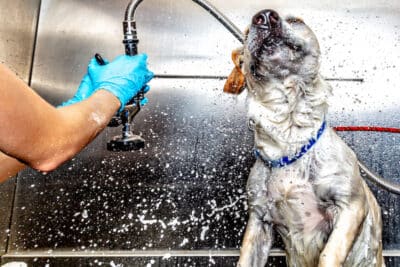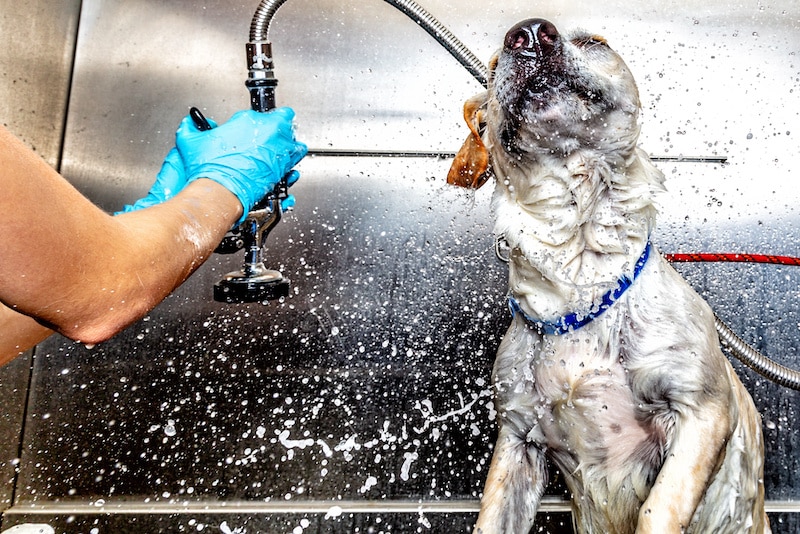The Australian Terrier is a small Terrier from Australia with oversized, pointed ears and a scruffy coat. You may take one look at this sweet dog and want to adopt one, but chances are you’re here because you want to know if your home will be filled with hair or not, right?
So, is the Australian Terrier a heavy shedder?
Well, the good news is that the Australian Terrier sheds minimally, and most of the fur it does shed ends up trapped within the coat due to its wiry texture. As for coat maintenance, while the Aussie is double-coated, grooming this breed is relatively straightforward, so regular brushing should be all that’s needed to keep the loose fur at bay!
This guide to the Australian Terrier will tell you everything you need to know. First, I’ll talk more about how often this Aussie breed sheds, then I’ll delve into grooming requirements. I’ll even discuss whether the Australian Terrier is hypoallergenic or not.
Recommended: Go here to see our top-rated dog hair blow dryers
Australian Terrier Shedding Guide
The Australian Terrier is not a heavy shedder in the least.
The breed has that in common with many other Terrier dogs, such as the Kerry Blue Terrier and the Bedlington Terrier.
Like those dogs, the Australian Terrier has a scruffy, wiry, rough coat. This style of coat is not conducive to much shedding. Coarse fur doesn’t come out as frequently as soft fur does.
The size of an Australian Terrier also makes this dog low-shedding. Considered a small breed, the Aussie dog stands at 11 inches tall and weighs 20 pounds in maturity.
Further, the length of an Australian Terrier’s coat is quite advantageous. This breed often sports longer fur, especially if you’re following breed standards.
When a dog’s fur grows, it’s across four “hair growth cycle” stages. They include anagen, catagen, then telogen, and finally, exogen.
Exogen is when hair exits the dog’s body. When a dog has short hair, it goes through the four hair growth stages frequently, which means it sheds quite regularly.
A longer-haired breed such as the Australian Terrier is likely to have more of a pause from anagen to catagen and then telogen to exogen phases, which tends to keep its fur intact for longer.
However, compared to his Terrier brethren, the Australian Terrier is moderately higher-shedding. And the reason for that is that the breed is double-coated.
Although most dogs that have a double coat originally lived in arctic conditions, a double coat can insulate in the summertime as well.
Dogs have insulation via their undercoat, which is short and often woolen. The Australian Terrier’s outer coat is that coarse, long, shaggy fur that repels dirt.
Nevertheless, even with a double coat, the Aussie sheds minimally, and the fur it does lose is typically trapped in the outer coat before it falls onto the floors and furniture. As such, the best defense against a fur-filled home is regular brushing.
Grooming Your Australian Terrier
Grooming this dog is about as easy as can be.
And I would recommend a pin brush for this breed’s rough, shaggy coat.
Brushing your Australian Terrier is beneficial for a variety of reasons. You’re pulling out the loose, dead fur before it can fall off your dog’s body. This will reduce shedding.
You’re also spreading skin oils across the dog’s rough coat, so it looks better. The skin underneath will itch less, which is another method for controlling shedding.
When brushing the Australian Terrier, go in the same direction as its shaggy coat grows. This makes brushing a bit time-consuming, as you can’t mindlessly do it. Your dog will be comfortable, though, and that’s what matters most.
As for how often you should brush, that depends on your preference and how much fur you’re noticing being dropped. Generally speaking, the minimum brushing frequency with an Aussie would be weekly, but this can be increased to daily brushing if you notice more fur around the home or come across knots, mats, or tangles too often with a more relaxed brushing routine.
What about trimming? It’s generally best not to trim the Australian Terrier’s coat unless you’re trying to make yours a show dog that follows breed standards.
In that case, then the face should display an inverted V that starts from the dog’s nose and goes all the way up the bridge of its muzzle. The rest of the facial fur should be longer, save for around the mouth.
The fur across the body should be kept at a consistent 2 ½ inches except for certain areas. The feet, the rear legs, and the tail should all be longer.
The neck is allowed to have furnishings of slightly longer hair as well, which makes a ruff. The ruff should combine well with the apron.
When trimming the forelegs, the hair here can grow longer past the hocks. You want the leg fur to be somewhat feathered.
Even if you’re not entering your Australian Terrier into a dog show, you still have to take care of the hair that gets in its eyes. This fur can grow quite long and obstruct the dog’s vision.
You can use your fingers to hand strip the fur here, or you can pull it out with tweezers. In both instances, you want to be firm with your grip but do not hurt the dog. This is a rather sensitive area!
Since the Australian Terrier’s outer coat resists dirt and grime, you shouldn’t have to worry about bathing your dog all that often. Wait until they look visibly filthy or begin to have that stinky dog smell.
The reason I suggest waiting as long as you can to bathe the Aussie dog is that when you apply dog shampoo on its outer coat, it can’t resist dirt as well afterward for a while.
Are Australian Terriers Hypoallergenic?
When it comes to scruffy, low-shedding dogs like the Australian Terrier, the question always comes up whether the dog is hypoallergenic.
This is a good chance for me to talk about what it means to be a hypoallergenic dog.
Hypoallergenic dog breeds reduce your rate of allergies if you’re allergic to pet dander, but they don’t prevent allergy symptoms altogether. That’s due to what pet dander is, as it’s dead skin.
You can’t get rid of the allergen altogether even if your dog doesn’t shed one iota since every dog has skin.
When a dog sheds minimally, then both fur and dander leave the dog’s body less frequently. That’s how allergy sufferers can potentially coexist with a hypoallergenic dog.
So, is the Aussie Terrier hypoallergenic?
The Australian Terrier isn’t 100% “hypoallergenic” because no dog is, but small dogs are the most hypoallergenic, and the Aussie dog meets those standards. Plus, as I just explained, low-shedding dogs are the best contenders for hypoallergenic breeds.
So, this breed is better than most for people worried about dog allergies.
The caveat is that it always depends on the individual dog as to how much dander you’ll notice around the home, and how sensitive you are to that allergen.
About the Australian Terrier
The Australian Terrier is a small Terrier breed from Australia that originated in the 19th century. Its Great Britain-based ancestors were rat and mice hunters, but the Australian Terrier was mostly a show dog.
With a spirited attitude, the Australian Terrier is affectionate, loving, and brave despite its size.
The Aussie dog is small enough that an apartment dwelling should be fine, but keep in mind that this breed has a lot of energy to burn. You’ll have to exercise your dog every single day, whether that’s in the home or outside.
You can always take your pup to a dog park if you don’t have a fenced-in backyard. Of course, homeowners with a yard are in a better position to satisfy this dog’s exercise requirements.
You really must exercise the Australian Terrier, or the breed can become bored and destroy the house. Check out this introductory video on the Australian Terrier to see the Aussie in action:
Although Australian Terriers themselves were not bred to hunt, their ancestors were, and so these Aussie dogs do possess a prey drive. Larger dogs won’t be a problem for the Australian Terrier, but breeds that are smaller than them could be.
The same goes for other animals. An Australian Terrier probably won’t chase a fully-grown cat, but a hamster or a gerbil? They most likely would.
With their fluff, cute looks, and affectionate streak, it’s no wonder the Australian Terrier is a favorite of children.
Since they’re so loyal, an Australian Terrier can act as the house watchdog. Even if not used in a watchdog capacity, this breed does usually bark a lot, but behavioral training can correct this.
Bottom Line
The Australian Terrier is a small Australian breed with a scruffy double coat that sheds minimally year-round. And with easy grooming, a sweet personality, and a tidy size, the Australian Terrier could just be the perfect dog for you!













Please note: By submitting a comment using the above comment form, you confirm that you agree with the storage and handling of your data by this site as detailed in our Privacy Policy.